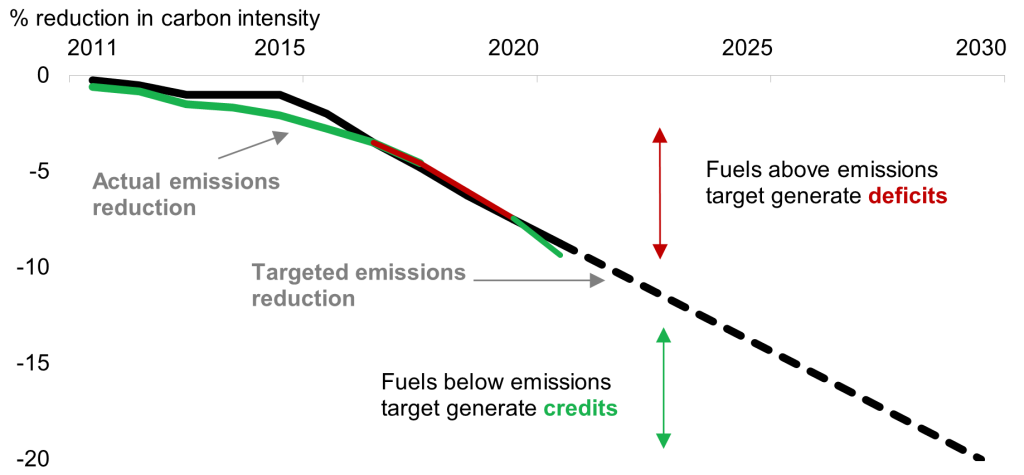Baseline and Credit Schemes for Electric Vehicle Charging: California
Implement effective compliance carbon-pricing mechanisms and integrate environmental considerations into trade policies
Overview
Transport is one of the fastest-growing sectors in terms of emissions, and passenger road vehicles accounted for 53% of the total in 2022. Electric vehicles are essential to reducing these emissions, but a lack of charging infrastructure could hinder adoption.
Some governments are considering carbon credit programs to tackle the charging conundrum, known as baseline-and-credit schemes. These are a type of carbon market but differ from the major allowance-based programs currently in operation.
Cap-and-trade schemes, such as the European Union’s Emissions Trading System, set an upper limit for the total emissions from entities covered by the program. These entities then need to either decarbonize or buy additional allowances to cover their emissions through regulated auctions or from other participants.
By contrast, baseline-and-credit schemes do not have an upper limit on emissions and instead operate in a system of “credits” and “deficits” based on a government’s emissions target. Fuel providers that exceed an annual emissions threshold generate deficits, while suppliers of alternative fuels – such as biofuels, biogas and electricity – that sell fuels with emissions lower than the target generate credits. A credit is awarded for every metric ton of CO2 equivalent avoided, meaning companies with deficits can balance their books, so to speak, by purchasing credits.
Baseline-and-credit schemes focus on a supplier’s emissions intensity, while cap-and-trade schemes concern absolute emissions. However, the two systems can also be implemented together, as seen in California, to further incentivize decarbonization. Under a cap-and-trade program, green fuel providers can sell their unused allowances and avoid paying fines associated with putting higher-emission fuels on the market. Then, under a baseline-and-credit mechanism, they would gain additional credits from producing fuel under the emissions target, which could be sold to a deficit-generating fossil-fuel producer.
Impact
The Low Carbon Fuel Standard (LCFS) in California is one of the most well-known versions of a baseline-and-credit scheme. The overall goal of the LFCS is to reduce the carbon intensity of transport fuels sold in the state by 20% by 2030 versus 2010 levels. The emissions reduction target increases on a yearly basis and will grow from 10% in 2022.
Emission reduction goals of California’s Low Carbon Fuel Standard program
 * Source: BloombergNEF, California Air Resources Board.
* Source: BloombergNEF, California Air Resources Board.
The total value of LCFS credits traded in 2021 exceeded $4.4 billion, with over 15% of credits awarded to electricity distributed for EV charging. Of the $585 million of credits that went to EV charging in 2021, 78%, or $445 million, went to utilities for residential charging, while $140 million went to fund charging outside of homes. EV charging comprised around 65% of electricity credits, with electricity delivered through forklifts, trams and rail making up the rest.
Opportunity
Electricity is increasingly being included in similar schemes around the world as a way to generate money to subsidize EV adoption and the rollout of charging infrastructure. In the EU, Germany and the Netherlands already utilize baseline-and-credit schemes that target electricity, in addition to participating in the bloc-wide Emissions Trading System. Furthermore, the Renewable Energy Directive (RED) III, which was approved in September 2023, sets minimum renewable electricity and fuel targets for transport for all EU members. All member states will be required to adopt credit schemes by 2025 to reach these targets.
In North America, there are schemes in place in Oregon and Washington in the US, and British Columbia in Canada, which largely follow the LCFS rules in California. Oregon has the most ambitious target, aiming to lower emissions by 37% by 2035 from 2015 levels. Other US states, including New York, New Mexico and Minnesota, have legislation under discussion.
California’s LCFS, and soon, the EU’s RED III, highlight the flexibility of baseline-and-credit schemes to complement existing market-based decarbonization policies and target both absolute emissions and emission intensity. Oregon and Washington’s regulations show how these credit schemes can also function as standalone policies, but with ambitious targets. Overall, these schemes can be implemented in a wide range of regions, with varying targets and designs to decarbonize the transport sector.
Read next
Related actions
Implement effective compliance carbon-pricing mechanisms and integrate environmental considerations into trade policies
- Power and Grids
- Industry and Materials
- Transport
- Buildings
- Agriculture
- Financials
- Consumers
- Companies